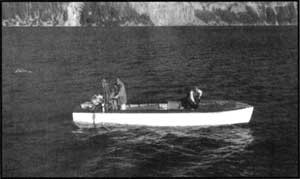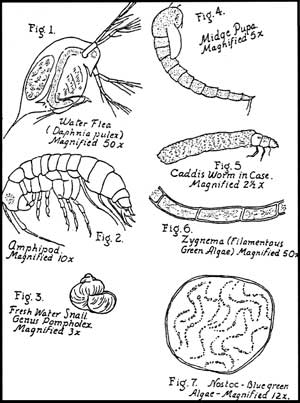Management concerns
 Research on Crater Lake in August, 1960. NPS photo by Jack Boucher. |
Crater Lake attracts an average of 500,000 people each year. Roughly 10 percent of these visitors walk down a relatively steep trail that serves as the sole access point to the lake in order to swim, go fishing or take the tour boat around the lake. Impacts to the lake from visitors are relatively minimal as far as is known, but long term trends or effects are still imperfectly understood. Waldo Lake attracts fewer visitors, but the lake is ‘at their campsite.’ Visitors can park a few feet from the lake, swim, launch a boat or camp. The 14 mile gravel road to Waldo Lake was paved in 1964 and visitor use increased dramatically. By 1982 visitor-use days reached 50,000 and that figure climbed to 103,000 visitor-use days by 1998. Waldo Lake appears to be more sensitive and at risk of being more impacted than Crater Lake, though restroom facilities near the shore are being replaced by composting toilets and more rustic campgrounds are being eliminated around the lake.
 Biota of Crater Lake. From Nature Notes, Vol. VIII, No. 2, Aug. 1935. |
Crater Lake has enjoyed a National Park Service sponsored research program since 1982. Between 1978 and 1981 some limited support helped to start a lake monitoring and research program. Crater Lake now has several full-time biologists and ecologists actively collecting data and working on research questions with an infrastructure of offices and laboratory facilities. A boat house on Wizard Island allows for research activities in winter as well as temporary living quarters and laboratory space. The two research boats on Crater Lake are similar to the research vessels used on Lake Tahoe and are versatile enough be employed in a wide range of studies.
Waldo Lake is not so well supported, though the Forest Service has stretched its limited watershed monitoring funds. The Oregon Department of Environmental Quality has also funded some limited research on the lake. There is no full-time limnologist or ecologist assigned to the monitoring efforts at Waldo Lake, though the writer has enjoyed some support for his involvement at Waldo Lake since 1986. The Forest Service has no boat, laboratory, nor equipment to monitor Waldo Lake and so must contract with others to do this work.
It should be said a research program involves measuring a wide array of chemical and biotic indicators for these two pristine lakes. Interested readers should examine the accompanying table for some of the indicators used as a basis for comparing Crater Lake with Waldo Lake. The references below are included for those wanting more specific information about past and present studies.
References
Ellen T. Drake, et al. (eds.), Crater Lake: An Ecosystem Study. San Francisco: Pacific Division of the American Association for the Advancement of Science, 1990.
Daniel M. Johnson, et al., Atlas of Oregon Lakes. Corvallis, Ore.: Oregon State University Press, 1985.
James F. LaBounty and Douglas W. Larson (eds.), Lake and Reservoir Management(journal issue devoted to Waldo Lake) 16:1-2 (2000), pp. 1-150.
James E. LaBounty and Gary L. Larson (eds.), Lake and Reservoir Management (journal issue devoted to Crater Lake) 12:2 (1996), pp. 221-310.
John Salinas studied lakes throughout Oregon after being inspired by Crater Lake as a seasonal naturalist. He teaches science at Rogue Community College in Grants Pass, Oregon.

